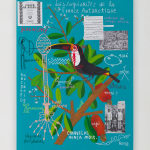Denilson Baniwa
Araçary, 2024
acrílica, pastel oleoso e colagem sobre tela
[acrylic, oil pastels and collage on canvas]
[acrylic, oil pastels and collage on canvas]
130 x 100 x 3 cm
[51 1/8 x 39 3/8 x 1 1/8 in]
4.6 kg
[51 1/8 x 39 3/8 x 1 1/8 in]
4.6 kg
Copyright O Artista
Mais imagens
Em 'Araçary', Denilson Baniwa narra a história de Kaali, um ser Baniwa que protege as roças e ensinou seu povo a cultivar e garantir sua subsistência. Para os Baniwa, Kaali...
Em "Araçary", Denilson Baniwa narra a história de Kaali, um ser Baniwa que protege as roças e ensinou seu povo a cultivar e garantir sua subsistência. Para os Baniwa, Kaali é o ancestral de todos os animais, considerados seus filhos e netos. Esses pássaros desempenham um papel essencial na disseminação de sementes, atuando como mediadores entre os Baniwa e Kaali. Além de povoar o mundo com sua presença, eles contribuem para o desenvolvimento da comunicação espiritual com Kaali, auxiliando no plantio e na criação de espaços agroecológicos. Dessa maneira, o artista se posiciona criticamente contra a lógica colonial que reduziu a natureza a um objeto de estudo passível de análise, dissecação e coleta.
[In “Araçary”, Denilson Baniwa tells the story of Kaali, a Baniwa being who protects the fields and taught his people how to cultivate and guarantee their livelihood. For the Baniwa, Kaali is the ancestor of all animals, considered to be their children and grandchildren. These birds play an essential role in the dissemination of seeds, acting as mediators between the Baniwa and Kaali. As well as populating the world with their presence, they contribute to the development of spiritual communication with Kaali, helping with planting and the creation of agro-ecological spaces. In this way, the artist takes a critical stance against the colonial logic that has reduced nature to an object of study that can be analyzed, dissected and collected.]
[In “Araçary”, Denilson Baniwa tells the story of Kaali, a Baniwa being who protects the fields and taught his people how to cultivate and guarantee their livelihood. For the Baniwa, Kaali is the ancestor of all animals, considered to be their children and grandchildren. These birds play an essential role in the dissemination of seeds, acting as mediators between the Baniwa and Kaali. As well as populating the world with their presence, they contribute to the development of spiritual communication with Kaali, helping with planting and the creation of agro-ecological spaces. In this way, the artist takes a critical stance against the colonial logic that has reduced nature to an object of study that can be analyzed, dissected and collected.]









